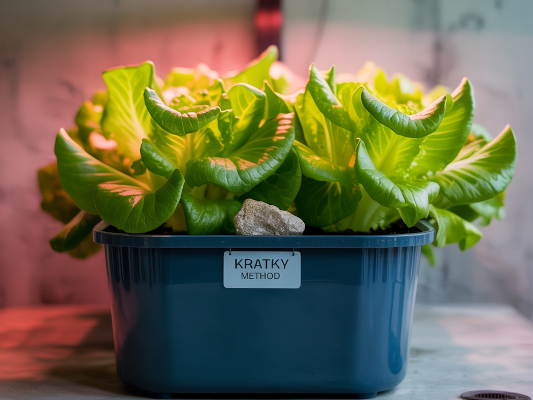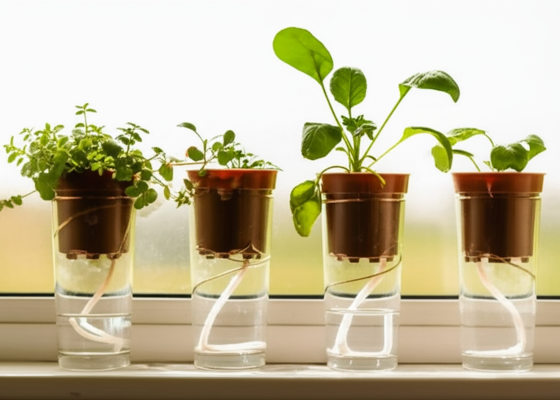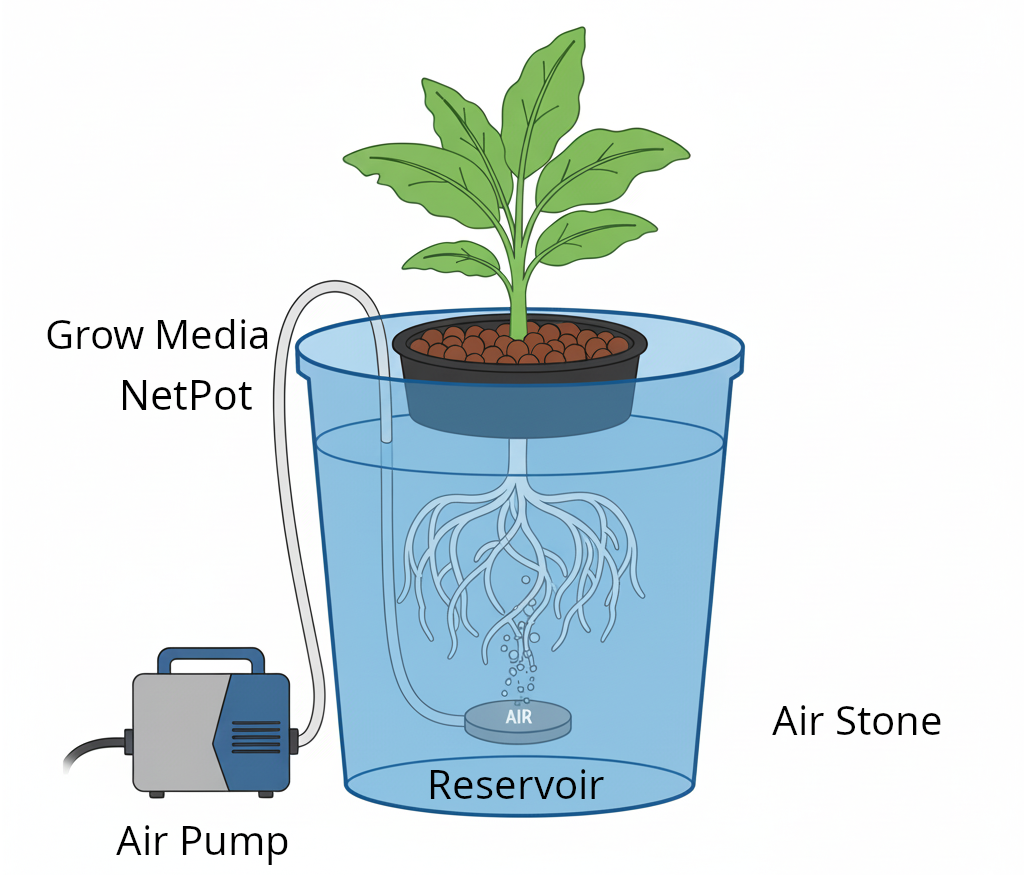Recirculating vs. Non-Recirculating
Recirculating (Closed-Loop)
The nutrient solution is pumped to the plants, and any excess runoff drains back into the same reservoir to be reused (e.g., DWC, NFT, Ebb & Flow).
Non-Recirculating (Run-to-Waste)
Nutrient solution is delivered to the plants, and the excess runoff is collected as waste rather than being reused (e.g., Kratky).
Active vs. Passive
Active Systems
Use pumps to move the nutrient solution (water pump) or provide oxygen (air pump). Examples include DWC, NFT, and Ebb & Flow.
Passive Systems
Have no moving parts and rely on gravity or wicking action to deliver nutrients. Examples include the Kratky method and Wick systems.
System Types by Plant Size
Small Plants & Leafy Greens
Systems like **Kratky and NFT** are ideal for lightweight, fast-growing plants like lettuce, herbs, and spinach. Their roots don't need extensive support, and the systems can be compact.
Large & Fruiting Plants
Systems like **DWC, Dutch Buckets, and Ebb & Flow** are better for larger, heavy-feeding plants like tomatoes, cucumbers, and peppers. They provide more space and support for extensive root systems and can meet higher nutrient and water demands.

The simplest, most passive hydroponic method. Plant roots hang in a static nutrient solution. As the plant grows, the water level drops, creating an air gap for the roots to breathe. No pumps or electricity needed.
Pros
- Extremely low cost and simple to build
- No electricity required
- Perfect for beginners and leafy greens
Cons
- Not suitable for large or long-lived plants
- Nutrient solution is not circulated or oxygenated
- Can't easily replenish nutrients without disturbing the plant

A basic, passive hydroponic system. A wick (like a rope or felt strip) draws nutrient solution from a reservoir up into the growing medium to feed the plant roots. It has no moving parts.
Pros
- Simple and low-cost setup
- No electricity or pumps needed
- Good for small, non-fruiting plants
Cons
- Limited oxygen to roots
- Not suitable for large or water-hungry plants
- Can struggle to provide enough nutrients

DIY systems often combine the simplest elements of various methods. While you can rely on the minimal aeration from a water pump, adding a small, separate air pump and air stone is a highly recommended, low-cost upgrade to significantly boost root health and plant growth.
Pros
- Highly customizable and affordable
- Great for learning core hydroponic principles
- Can be adapted to any space or plant type
Cons
- May lack the efficiency of optimized commercial systems
- Requires research and trial-and-error
- Performance depends heavily on the quality of the build

One of the most popular and simple active hydroponic systems. The plant roots are suspended in a reservoir of nutrient-rich, oxygenated water. An air pump with an air stone constantly bubbles oxygen into the solution, preventing root rot and promoting rapid growth.
Pros
- Low maintenance once set up
- Fast plant growth due to high oxygen levels to the roots
- Relatively inexpensive and easy to build
Cons
- Dependent on electricity for the air pump
- Water temperature can be hard to manage in the reservoir
- Pump failure can be catastrophic if not caught quickly as roots can drown

A unique, gravity-fed system that waters plants from below. Each pot has a smart valve (AQUAvalve) that opens to allow nutrient solution into the tray and closes when the plant has had enough. It's a very efficient, low-maintenance, and expandable system.
Pros
- Extremely water-efficient
- No electricity, pumps, or timers required
- Very low maintenance and scalable
- Mimics natural wet/dry cycles for roots
Cons
- Higher initial cost per pot
- Relies on a specific valve mechanism that can clog
- Not ideal for bare-root growing

A versatile system where a pump delivers nutrient solution through a network of tubing and releases it slowly through emitters that drip directly onto the base of each plant. It's highly configurable and can be either recirculating or non-recirculating (run-to-waste).
Pros
- Water and nutrient efficient
- Highly customizable for different plant sizes
- Reduces risk of algae growth on the surface
- Scalable from small to large setups
Cons
- Drip emitters can clog easily
- Requires a reliable pump and timer
- Setup can be more complex than DWC or Kratky

A popular type of recirculating drip system, ideal for large vining plants like tomatoes or cucumbers. Each plant is in its own bucket with a growing medium (like perlite). A pump sends nutrient solution through drip lines to each bucket, and any excess solution drains back to the reservoir to be reused.
Pros
- Great for large plants
- Individual plant control and less risk of disease spread
- Scalable and highly configurable
- Efficient use of water
Cons
- Can use a lot of growing medium
- Requires a pump and timer
- Can be prone to clogs in drip lines if not filtered

This system works by periodically flooding a grow tray with nutrient solution from a reservoir, and then draining it back out. A timer controls a pump to automate this process, which provides both nutrients and excellent root aeration.
Pros
- Excellent root aeration as roots are exposed to air between cycles
- Efficient use of water and nutrients
- Versatile and works with many types of growing media
Cons
- Requires a reliable timer and pump, which can fail
- Media can get clogged with roots or debris
- More complex plumbing than DWC

A continuous, shallow stream of nutrient solution flows over the bare roots of plants in a watertight channel or gully. The system is slightly sloped to allow water to flow back to the reservoir by gravity, creating a 'film' of nutrients.
Pros
- Low water and nutrient consumption
- Easy to inspect roots for disease
- Very scalable for commercial use, especially for leafy greens
Cons
- Highly susceptible to pump failures (no media to hold water)
- Roots can clog the channels if not managed
- Not suitable for plants with large taproots

A space-saving approach where plants are grown in vertical stacks. These can be towers or wall-mounted panels. Vertical gardens often use another hydroponic technique (like NFT, drip, or aeroponics) to deliver water and nutrients to the stacked plant sites.
Pros
- Maximizes growing space in small areas
- Can be aesthetically pleasing
- Highly efficient for certain crops like strawberries and lettuce
Cons
- Can be expensive to set up
- Light may not reach lower plants evenly without careful planning
- Maintenance can be more difficult on higher levels

The most advanced hydroponic method. Plant roots hang in the air within a chamber and are periodically misted with a nutrient solution from high-pressure sprayers. This method provides maximum oxygen to the roots, leading to faster growth and higher yields.
Pros
- Highest level of root aeration leading to extremely fast growth
- Requires very little water compared to other systems
- No growing medium needed
Cons
- Very sensitive to pump/mister failure; roots dry out in minutes
- Misters can clog easily and require maintenance
- Higher initial setup cost and complexity
Tips for System Success
Cleanliness is Key
Regularly clean your reservoir and system components (at least every 2-3 weeks) to prevent algae growth and salt buildup, which can clog pumps and harm roots.
Check Your Equipment
If using an active system, check daily that your pumps are running and that water is flowing correctly. A failed pump can destroy a crop in hours.
Manage Water Temperature
The ideal water temperature is 18-22°C (65-72°F). High temperatures reduce dissolved oxygen and increase the risk of root rot, the #1 killer of hydroponic plants.
Start Simple
If you're a beginner, master a simple system like DWC or Kratky before moving on to more complex methods like NFT or Aeroponics. The principles you learn will apply to any system.